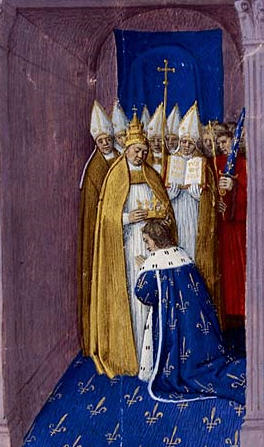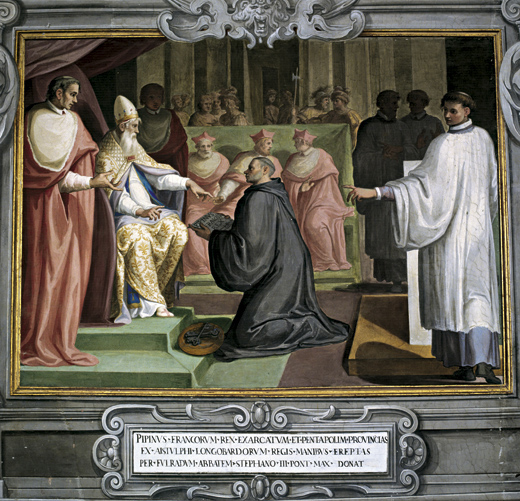 |
| Pepin the Short |
A Time of Consolidation
Pepin the
Short was the son of the Frankish prince Charles Martel. When
Charles died in October 741, Pepin was the Mayor of
the Palace[i] of Neustria while his
brother Carloman took the
position of Mayor of the Palace at Austrasia[ii]. Pepin took
Austrasia from his brother’s son Drogo a year
after his brother retired to the monastery at Monte Cassino in August
747[iii]. Drogo resisted Pepin’s
annexation of Austrasia until his capture in 753; he was then imprisoned.
In 750 an emissary from Francia travelled to Rome; it would appear that Pepin
had decided to clear up what was clearly to him an analogous position; he wrote
to Rome for clarification; should the Frankish throne belong to one who had no ‘kingly powers’? Abbot Fulrod and Bishop
Burchard’s trip produced the required answer;
‘Pope
Zacharias instructed Pippin that it was
better to call him king that had power than him without royal power.’[iv]
By 751 King Childeric
III[v] had been
deposed and Pepin elected King Pepin III and annointed by Archbishop Boniface.
A Son and Heir
 |
| Einhard |
Charles was Pepin’s
son elder son by his then leman Bertrada of Laon. Records are divided about Charles[vi] exact date of birth[vii], but he was probably
born in April 742. Pepin and Bertrada got married in 749, legitimising Charles’s
position as his father’s heir. Their second child Carloman was born
in 751 and their daughter Gisela[viii] was born
in 757[ix].
There is very little record about Charles’s early years. Even Charles’s earliest
biographer Einhard[x] was wary
of writing about Charles’s infancy;
‘It would be foolish of me
to say anything about his birth and infancy, or even about his boyhood, for I
can find nothing about these matters in writing, nor does anyone survive who
claims to have personal knowledge of them.’[xi]
The children were not sent away to the abbey school of St Denis in Paris as their
father had been; possibly Pepin was afraid that Charles and Carloman might be
kidnapped or murdered. Instead the boys stayed with Pepin’s peripatetic court
as it made its way around Pepin’s territories.
Pepin had the boys educated along with the sons of his most trusted
followers, learning to ride and fight. Military training began in earnest at
the age of six and the children were taken on campaigns. Charles learned his
letters but never learned to write, something he much regretted in later life. Both
Charles and Gisela were imbued with a love of culture and learning, possibly
from the circle of scholars that surrounded their mother.
Learning the Art of Kingship
I
n 753 when Pope Stephen II made his
journey across the Alps at the
end of 753 Pepin sent the eleven year old Charles as head of the welcoming
party. Stephen’s mission was to gain allies to fight off the threats from the Lombards and from Al-Andalus[xii].
 |
| Pope Stephen II |
During his stay Stephen re-consecrated Pepin as king of Francia at St
Denis; Charles and Carloman were both included in the ceremony. Two years later
the boys both took part in another important ceremony in Auxerre; the
transfer of the bones of St
Germanus to a new shrine.
Pepin’s rule now stretched from the Atlantic coast to the Danube. When Charles was
fifteen Pepin assigned his older son over-lordship of several duchies,
including some whose loyalty was suspect. Pepin’s major problem was Aquitania where the
local dukes, assisted by their neighbours the Vascones, resisted
Frankish sovereignty. Pepin fought in the southwest year after year and Charles
and Carloman took an increasingly prominent part in the expeditions.
In June 768 one of the main dissidents Duke Waiofar was
assassinated by some of his own fighters. The end of the fighting in Aquitania
found Pepin a sick man, who managed to wend his way to St Denis and made
provision for his children before dying in September. The three provinces of
Austrasia, Neustria and Aquitania were divided into half and Charles and
Carloman each received their halves as required by Frankish law.
‘[Pepin] died at Paris of
the dropsy, and left behind him two sons, Charles and Carloman, to whom by
divine will the succession of the kingdom came. For the Franks called a solemn
public assembly, and elected both of them to be kings.’[xiii]
Neither brother was pleased with the end result.
Ruling in Tandem
 |
| Francia at Pepin's death |
Charles and Carloman were consecrated as kings of their respective
domains at the Abbey of St Denis on St Denis’ saint’s day of 9th
October 768. Charles was twenty-five and Carloman eighteen, neither of them
ready to submit to the direction of others. Carloman’s lands included Paris and
Soissons[xiv] cutting Charles’
lands from direct access to Rome. Charles’s resentment increased when, the
following year, Aquitania rose in revolt; he called on Carloman to come to his
assistance.
The two brothers met in Vienne and
immediately started arguing. Carloman led his army home and Charles marched his
to Aquitania and an easy victory over the rebels. The ease of his victory did
not assuage Charles’s anger at Carloman.
In 770 both brothers became fathers for the first time. Carloman’s wife Gerberga gave
birth to a boy that Carloman named Pepin after his father[xv]. A few months later Charles’s
partner Himiltrud gave
birth to a boy who was also named Pepin[xvi]. This
increased the rivalry between the two brothers.
Pope Stephen was concerned about consolidating his position as the
legitimate pope[xvii]
and for that needed strong allies in the Frankish kings. Having Carloman and Charles
at odds with each other did not serve his purposes. Stephen wrote to the two
brothers urging them to ensure the observance of
‘The
rights of the Prince of the Apostles.’[xviii]
The pope’s
main supporter in Italy Desiderius King of
the Lombards was refusing to honour a commitment[xix] to return five Italian
coastal towns to papal rule and he had made Sergius, one of his supporters, Archbishop of Ravenna[xx] undermining
Stephen’s rule.
Discord
Carloman had agents in the papal entourage; Christopher and his son
Sergius were leading officials in the papal bureaucracy. Carloman’s contacts in
Rome were more influential that Charles’. But Christopher and Sergius were
hangovers from the previous pope[xxi] whom Stephen viewed with
suspicion. Bertrada was concerned that the conflict between Charles and
Carloman could endanger her husband’s legacy.
Bertrada emerged from the home[xxii] she had ensconced
herself in and journeyed across the Alps. She first visited Carloman to urge
him to stop intriguing against Charles, a thankless and unsuccessful task. Her
next stop was the court of Duke
Tassilo III, Duke of Bavaria, married
to one of Desiderius’ daughters.
En route to Bavaria Bertrada conceived the plan of marrying Charles to
another of Desiderius’s daughters. This would give Charles an alliance with
both Bavaria and Lombardy and giving him the access to Rome that he needed.
With the support of Tassilo Bertrada then travelled on to her final destination
for a conference with the pope. Stephen was horrified by the idea, sending
messages north warning Charles not to ally himself with;
‘The
faithless and most vile Lombard people.’[xxiii]
Ignoring Stephen’s plea Charles put aside Himiltrude[xxiv] to marry Desiderata[xxv]. The new
alliance resulted in an agreement over the vexed question of the five towns
which were returned to papal control; Carloman’s contacts in the papal
entourage lost their places and eventually their lives after being blinded by
Desiderius’ men. Desiderius’ appointment of Archbishop of Ravenna was replaced
by Leone I, a man of Stephen’s choosing.
Bibliography
The Cambridge Illustrated History of the Middle Ages – Robert Fossier
(ed), Cambridge University Press 1989
The Oxford History of Medieval Europe – George Holmes, Oxford University
Press 2001
Absolute Monarchs – John Julius Norwich, Random House 2011
Emperor of the West – Hywel Williams, Quercus 2010
Charlemagne – The Great Adventure – Derek Wilson, Hutchinson 2005
www.wikipedia.en
[i]
Manager of the Frankish king’s household
[iii]
It is possible that Carloman and Pepin came to an agreement that Pepin, without
legal heirs at the time, would name Drogo has his heir
[iv]
Emperor of the West - Williams
[vi] Or Karolus; known to posterity as
Charlemagne
[vii] Anywhere from 742-8AD
[ix]
Bertrada had five other children who died in infancy
[x]
One of Charles’s courtiers
[xii]
Islamic Spain
[xiv]
The old capital
[xv]
In doing so Carloman was laying claim to be his father’s successor
[xvi]
He was called Pepin the Hunchback which may explain why Charles did not marry
Pepin’s mother
[xvii]
The death of Pope Paul I
had led to vicious infighting and two rival nominations for pope who were
removed by the rival groupings, one led by King Desiderius of Lombardy who had Pope Constantine
II’s eyes put out and placed his candidate Philip on the papal
throne
[xviii]
Emperor of the West - Williams
[xix]
Made to Pepin the Short when campaigning on behalf of the Holy See
[xx]
One of the towns in question
[xxi]
Pope Zachary
[xxiii]
Charlemagne - Wilson
[xxiv]
There is a possibility that Charles and Himiltrude were married
[xxv]
Also known as Ermengarda
interestingly the name Charles of course survives until today; Tassilo until the 14th century, and Pepin only survived in pre plague Italy [up to 1349] not in France. Carloman? disappeared.
ReplyDelete